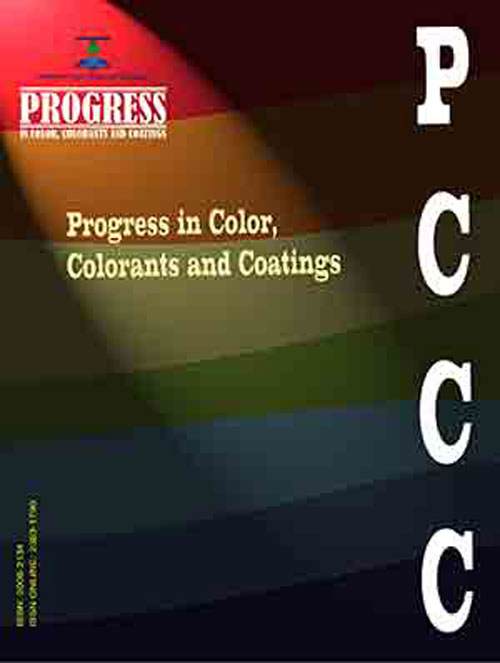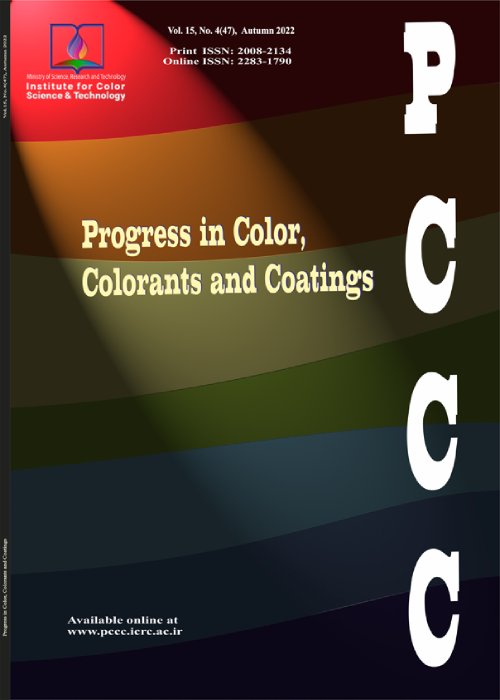فهرست مطالب

Progress in Color, Colorants and Coatings
Volume:12 Issue: 3, Spring 2019
- تاریخ انتشار: 1398/03/11
- تعداد عناوین: 6
-
-
Pages 133-144This study was conducted to assess the ability of the studied adsorbent, i.e. raw oak fruit hulls and the activated carbon prepared from oak fruit hull for removing the Methylene blue (MB) from aqueous solution. This study was conducted under various effective parameters, e.g., contact time, pH, MB concentration, adsorbent concentration. The optimum amount of each parameter was determined and the isotherm and kinetic studies were also carried out. The results revealed that the best results for MB removal efficiency are observed using the activated carbon prepared from oak fruit hulls. It was also observed that increasing the contact time, pH and adsorbent concentration provides better condition to enhance the dye removal efficiency and increasing the MB, hence reducing the removal efficiency. Furthermore, the results also clarified that the best models to describe the MB adsorption onto the raw oak fruit hulls and activated carbon are the Langmuir model 1 (R2=0.9971) and Langmuir 2 (R2=0.7631), respectively. In addition, the adsorption of MB onto the raw oak fruit hulls and activated carbon are better fitted to pseudo-second-order model and zero-order model, respectively. Finally, it can be concluded that the activated carbon prepared from the raw oak fruit hulls is more valuble than the raw oak fruit hull for removing the MB.Keywords: Adsorption, Activated carbon, Oak fruit hull, Methylene blue, Aqueous solution
-
Pages 145-154Pulicaria gnaphalodes has various biological activities and is used as an herbal plant in traditional medicine. The major components of the aqueous extract of this plant are flavonoids, terpenoids and phenolic compounds which could be a good candidate for dyeing of wool fibers. In this study, the aerial part of Pulicaria gnaphalodes plant was extracted and used for the coloration of wool yarns. Firstly, the chemical components of the Pulicaria gnaphalodes extract were identified using a gas chromatography-mass spectrometer (GC-MS). After that, the effect of dyeing procedure parameters such as mordant concentration, pH of dyeing bath, dyeing duration, and dye concentration was assessed on the color characteristics of the dyed yarn samples. The results and observations indicate that the un-mordanted and alum mordanted dyed samples have a yellow color and their hue angle value is located between Huemax= 89.11° and Huemin=76.49°. The obtained yellow shade at the optimized dyeing condition presented a considerable good washing and light fastness. In addition, the aqueous extract of aerial parts of Pulicaria gnaphalodes presented an inhibitory effect against S. aureus and E. coli bacteria.Keywords: Natural dyeing, yellow color, Antibacterial, Flavonoid, color characteristic
-
Pages 155-161New bacteria that was provided from contaminated soils surrounding the coal, aluminum, salt mines and wetland separated, synthesized and characterized. The achievements show that this soils and waters have five disposed bacteria consist of Microbacterium SP, Micrococcaceae Bacterium, Planomicrobium SP, Brevndimonas Aurantiaca and Halomonas SP. Secondly, the result of the potential of removal activity study of new bacteria, with respect to basic blue 41 and disperse red 177 dyes are presented. So, in the batch system the influence of pH, bacteria dosage, temperature, dyes initial concentration and time was investigated. Finally, the study of removal mechanism show that the biodegradation is the governing mechanism. So, we can confirmed that these natural and locally available bacteria showed a great efficiency for the removal of dyes from the aqueous solution without any unsafe by-product, also can be utilized for other water pollutants.Keywords: Microbacterium SP, Halomonas SP, Dye biodegradation, Soil, water bacteria
-
Pages 163-177Herein, magnetic cobalt ferrite nanoparticles (CFNPs) was synthesized and its surface was modified by cationic surfactant (cetyltrimethyl ammonium bromide: CTAB) and its potential to selective removal of dye from multicomponent (ternary) system was investigated. Direct red 31 (DR31), Direct green 6 (DG6) and Direct red 23 (DR23) were used as a model dyes. The characteristics of the synthesized adsorbent (CFNPs-CTAB) nanoparticles were studied using FTIR, SEM, TEM, XRD, and TOC. Selectivity analysis showed that the magnetic adsorbent had selective removal of DR31. A reliable and intelligent model based on Least-Squares Support Vector machine (LS-SVM) was used to present pollutant adsorption efficiency. The presented model illustrates better performance in predicting dye removal efficiency compared to the kinetic models with average absolute percent relative error of 2.024% and correlation coefficients close to unity. Moreover, it was showed that the developed models are capable of simulating the actual physical trend of the dye removal efficiency with variation of adsorbent dosage, initial dye concentration, salt and initial pH of solution. The proposed model could be trustful for predicting the dye removal efficiency from colored wastewater.Keywords: Synthesis, Cobalt ferrite nanoparticle modification, Surfactant, Ternary system dye removal, Selectivity analysis, Intelligent modelling
-
Pages 179-190Biological treatment, especially enzymatic methods, can be employed for effective and environmental- friendly treatment of dye effluents. Laccase, belonging to the blue multi-copper oxidases category, can oxidize a wide variety of substrates, especially synthetic dyes. In this study, laccase was used to biodegrade two azo dyes, i.e., Direct Red 23 and Acid Blue 92. Before conducting the experiments, the laccase used in this study was enzymatically characterized. Face-centered central composite design (FCCCD) was used to optimize the main parameters of the decolorization process. The optimum conditions to maximize the bio-decolorization process of AB92 were X1=11.85 mg L-1, X2=5.10, and X3=98.37 mg L-1, with a decolorization extent of 92.30%. These conditions for DR23 were X1=17.68 mg L-1, X2=3.70, and X3=97.89 mg L-1, with a decolorization extent of 95.60%. The optimum conditions for both dyes showed that the enzymatic decolorization favored lower dye concentration. Considering the ANOVA analysis data, the synergetic interactions orders were as follow: AB92: dye concentration-enzyme dosage> dye concentration-pH> enzyme dosage-pH; DR23: dye concentration-pH> dye concentration-enzyme dosage> enzyme dosage-pH.Keywords: Laccase, Dye, enzymatic decolorization, central composite design
-
Pages 191-201Nowadays, there is a great tendency for eco-dyeing and finishing of textiles with natural products. several natural dyes have been used for dyeing of protein fibers but a low number have the ability to dye cotton fiber because of low affinity of cellulose to the natural dyes. In this study madder and weld natural colorants were used to dye cotton fabric premordanted with three metallic salts including alum, ferrous sulfate, and copper sulfate. The effects of the concentration of mordant, dyeing temperature, dyeing time and amount of electrolyte on the color strength of dyed samples were investigated. Also, an eco-friendly process, low temperature plasma treatment was employed as a pretreatment to improve the dye exhaustion into the cotton fibers. The fastness properties of cotton samples dyed under different conditions were evaluated and the optimum amount of each variable for obtaining the highest values of color strength and fastness properties in the dyeing of cotton with madder and weld natural dyes was specified.Keywords: cotton, Natural Dye, Plasma, Mordant, Fastness properties


